The strange public relations campaign surrounding the monkeypox outbreak took another turn Saturday, as the World Health Organization (W.H.O.) announced it would no longer distinguish between “endemic and non-endemic countries” to create a more “unified response” to the disease.
In its latest “multi-country monkeypox outbreak” update — an awkward moniker chosen because the number of cases is far too small to classify monkeypox as a “pandemic” — W.H.O. counted just 2,013 confirmed cases spread across 42 countries, plus one “probable” case, and one fatality.
“The outbreak of monkeypox continues to primarily affect men who have sex with men who have reported recent sex with new or multiple partners,” W.H.O. duly noted.
“W.H.O. assesses the risk at the global level as moderate considering this is the first time that many monkeypox cases and clusters are reported concurrently in many countries in widely disparate W.H.O. geographical areas, balanced against the fact that mortality has remained low in the current outbreak,” the update said.
Until now, monkeypox has rarely spread outside its “endemic” environment of western and central Africa, but because the current outbreak features so many cases in other parts of the world, W.H.O. decided to stop making such geographical distinctions.

This 2003 electron microscope image made available by the Centers for Disease Control and Prevention shows mature, oval-shaped monkeypox virions, left, and spherical immature virions, right, obtained from a sample of human skin associated with the 2003 prairie dog outbreak. (Cynthia S. Goldsmith, Russell Regner/CDC via AP)
“In this edition, we are removing the distinction between endemic and non-endemic countries, reporting on countries together where possible, to reflect the unified response that is needed,” the update stated.
W.H.O. officials appeared frustrated that non-endemic countries are not taking monkeypox seriously enough, because they anticipate the surge of cases will fade away once a fairly specific subset of their populations desists from the behavior that spreads it.

This 1997 image provided by U.S. Centers for Disease Control and Prevention shows the right arm and torso of a patient, whose skin displayed a number of lesions due to what had been an active case of monkeypox. (CDC via AP)
“Confirmation of one case of monkeypox, in a country, is considered an outbreak. The unexpected appearance of monkeypox in several regions in the initial absence of epidemiological links to areas that have historically reported monkeypox, suggests that there may have been undetected transmission for some time,” the update warned.
W.H.O. will hold an emergency monkeypox meeting on Thursday, June 23. The agenda will include discussing a new name for the disease because some virologists argue the “nomenclature of this virus being African is not only inaccurate but is also discriminatory and stigmatizing.”
This could be a difficult politically-correct linguistic needle for W.H.O. to thread, because in truth “monkeypox” is not an inaccurate name. W.H.O. itself states that monkeypox is a “zoonotic” disease, primarily spread from animals to humans. The animals involved are most commonly monkeys, although the disease has been found in some rodents as well.
“Human-to-human transmission is limited, with the longest documented chain of transmission being 6 generations, meaning that the last person to be infected in this chain was 6 links away from the original sick person. It can be transmitted through contact with bodily fluids, lesions on the skin or on internal mucosal surfaces, such as in the mouth or throat, respiratory droplets and contaminated objects,” the W.H.O. fact sheet on monkeypox explains.
“Monkeypox is rare and does not spread easily between people without close contact. The threat of monkeypox to the general U.S. population remains low,” the U.S. Centers for Disease Control (CDC) states on its fact sheet.
There is nothing “stigmatizing” about observing that people who live in close proximity to the animals who spread a particular disease are most likely to catch that disease.
The problem, from the perspective of the virologists who argue for renaming monkeypox, is that people living outside the endemic region are not sufficiently worried about the disease blowing up into a pandemic. The handful of cases detected so far are not convincing Europeans and Americans that monkeypox is here to stay.
W.H.O. tech expert Rosamund Lewis told Canada’s CBC News on Friday that renaming monkeypox “may not be as straightforward” a proposition as some people think, because the disease has been “commented on, published on” for over 50 years. Changing the name could make accessing past research and commentary much more difficult, which seems like a bad idea in the middle of an outbreak.
Thursday’s W.H.O. meeting will also discuss whether to classify monkeypox as a “public health emergency of international concern,” which would be the strongest alarm the agency can sound without declaring an all-out pandemic.
CDC has reported monkeypox cases in 22 states as of this weekend, the latest additions being Missouri and Indiana, although those cases are still awaiting clinical confirmation.
“The risk of monkeypox among the general public continues to be extremely low. Monkeypox is rare and does not easily spread through brief casual contact,” said Indiana State Health Commissioner Kris Box.
“Please continue to take the same steps you do to protect against any infection, including washing your hands frequently and thoroughly, and check with a healthcare provider if you have any new signs or symptoms,” Box advised.
Monkeypox is very unpleasant, although rarely fatal. The signature feature of infection is a painful rash, although W.H.O. has expressed concern that milder infections might not produce much of a rash, so some infected people could spread the disease without realizing they have it.

COMMENTS
Please let us know if you're having issues with commenting.